1964: Baltimore Colts @ Cleveland Browns
This series covers the history of the NFL through the prism of its yearly championship games.
Note: The gray boxes contain asides that provide interesting material but could be skipped
without losing the continuity of the article.
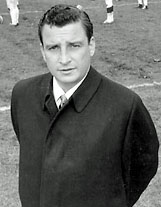
Art Modell
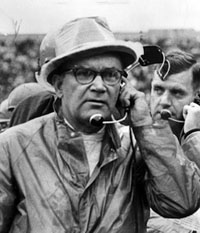
Blanton Collier
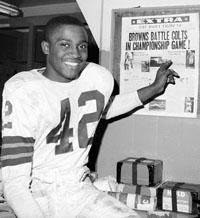
Paul Warfield
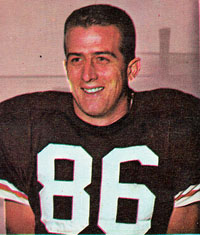
Gary Collins
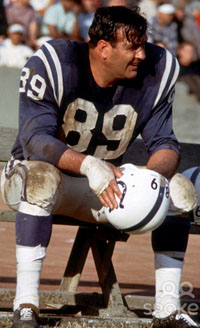
Gino Marchetti
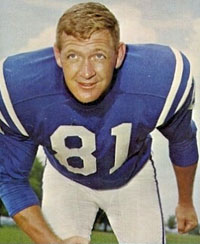
Ordell Braase
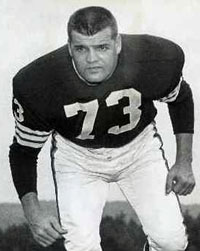
Monte Clark

Dick Schafrath
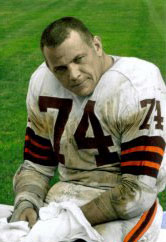
Dick Modzelewski
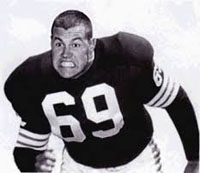
Jim Kanicki
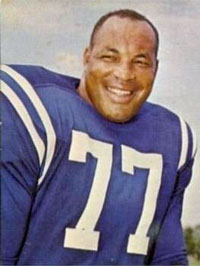
Jim Parker
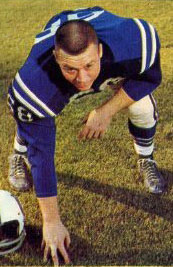
Alex Sandusky
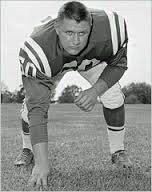
George Preas
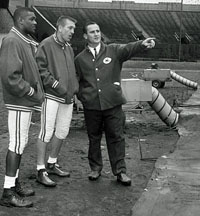
Lenny Moore, John Unitas, and Don Shula survey field day before game.
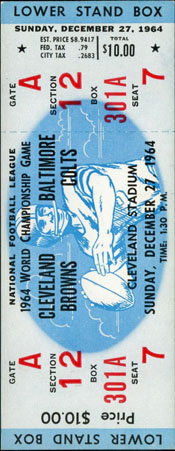
|
The '64 season saw two teams that had been successful in the 1950s return to their former glory.
It's impossible to talk about what happened with the Cleveland Browns in 1964 without talking about what happened within the franchise the previous three years.
- 35-year-old Art Modell and his partners purchased the Browns in 1961 for $4 million. Unlike the team's previous owners, Modell immediately took an active role in the management of the team. That led to clashes with the legendary Paul Brown, the only coach the team had known since its inception in 1946 and the man who had won all four All-America Football Conference championships and three more in the NFL.
- Following a 7-6-1 record in 1962, Cleveland's fourth straight season without winning the NFL East Division championship, Modell shocked the sports world by firing Brown.
- As his new coach, Art chose 57-year-old Blanton Collier, a longtime assistant to Brown (1945-1953) who had been coaching Kentucky for eight years.
- The Browns improved to 10-4 in 1963 but lost the East crown to the 11-3 Giants.
- Aided by the collapse of the aging Giants, who plummeted to the East cellar with a dismal 2-10-2 mark, Cleveland returned to the top of the division in 1964 with a 10-3-1 record.
Any discussion of the '64 Browns must begin with their star FB.
- Since joining the club in 1957, Jim Brown had led the NFL in rushing seven of eight years, the only exception being 1962 when Brown fell to fourth on the list that was headed Green Bay's Jimmy Taylor.
Brown carried the ball only 230 times in '62, down from 305 the previous season. This proved to be a major bone of contention between Modell and Paul Brown, the owner insisting that his star be used more often.
The '64 NFC Championship provided particular gratification for Jim Brown because former Cleveland star QB Otto Graham had criticized Jim's blocking and predicted the Browns would never win a championship with Jim as the center of their offense.
- QB Frank Ryan, a math whiz from Rice University, performed capably but not spectactularly. He completed 52.1% of his passes with 25 TD to 19 interception. His top receiver was rookie Paul Warfield from Ohio State, who snared 52 balls for 920y. Brown was next with 36 receptions (340y), one ahead of the other flanker, Gary Collins (544y).
Ryan credited Collier with instilling confidence in him when Blanton arrived in 1963.
- The Browns defied the conventional wisdom that defense wins championships. They finished dead last in yards allowed (4,722) and gave up 20 more first downs than any other team. But they were fifth in points allowed (293), showing their "bend but not break" resiliency.
The Baltimore Colts won their first West Division title since their back-to-back NFL championships in 1958 and 1959.
- 34-year-old Don Shula led the club to a 12-2 mark in his second year at the helm to earn Coach of the Year honors. As in the East, the defending champion, the Bears, fell off drastically to 5-9. The Vikings and Packers tied for second with 8-5-1 records.
Shula played for the Browns in 1951-52 when Collier served on Paul Brown's staff. Don later spent two years as an assistant to Blanton at Kentucky. Collier praised his title game counterpart. Don Shula knows a lot more about coaching than his years would indicate. I never knew a player with as fine a football mind. He always thought about coaching, even when he was playing. So I'd say he's had the experience of a man in the profession for ten years.
- The Colts led the league in points allowed, 16.1 per game. Four veterans from the 1958-59 champs continued to lead the defense: LE Gino Marchetti, talked out of retirement for one more year, RE Ordell Braase, RLB Don Shinnick, and MLB Bill Pellington, 37 like Marchetti, which made them three years older than their head coach.
Shinnick made one of the key plays of the year for the Colts. In the opener against Green Bay, the Colts clung to a one-point lead in the final minutes as the Packers moved within easy field goal range. But Bart Starr decided to go to the air, and Shinnick intercepted.
- The one and only Johnny Unitas continued to guide the offense, which set an NFL record with 54 touchdowns. Despite rumors of arm trouble, the 31-year-old made first-team All-Pro and AP Player of the Year, throwing for 2824y with a 51.8 completion %, 19 TD, and 6 interception. He still had old pal Raymond Berry to throw to (43 catches for 663y) but also enjoyed tossing to Jimmy Orr (40 receptions for 867y).
- Another 31-year-old, Lenny Moore, led the runners although he outgained Tony Lorick, eight years his junior, by just 71y (584-513). But the two combined didn't come close to Brown's 1,446. Lenny had set a league record with 19 TDs.
- Four more '59 vets anchored the offensive line: Jim Parker (moved from T to G), G Alex Sandusky, T George Preas, and C Dick Szymanski.
- A statistic not kept at the time shows why the Colts and Browns had successful seasons. Baltimore ranked first in yards-per-play (5.7) with Cleveland a close second (5.6).
Although he never showed it publicly, Unitas did not like–some say hated–Shula. C Buzz Nutter: If you were going to spend any time with Unitas, the first thing you had to know was never to say anything nice about Shula in front of him. Dr. Edmond McDonnell, the Team Physician, said, There was an enmity there that never ended. I'd whisper, "For God's sakes, John, throw him a bone." But John wouldn't. He didn't believe in diplomacy. "If that's what you want," he'd tell Shula, "that's what you'll get." John doesn't let up. He'd say to writers, "Don't ask me, ask Shula. It's his team." Shula himself said, It was John's personality. It was my personality. It was his confidence in his own ability. It was my belief in how things should be done. I'm not a guy who finesses things, and John was never a finesse guy either. You always knew where John stood, just like you always knew what I was thinking.
1964 Baltimore Colts Coaching Staff
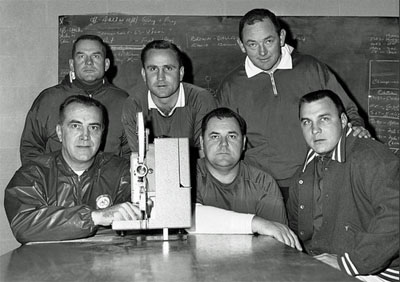
Seated L-R: Don McCafferty, John Sandusky, Dick Bielski
Standing L-R: Charlie Winner, Don Shula, Bill Arnsparger
With no playoff needed to determine either conference champion, the teams had two weeks to prepare for the big clash.
- That provided Blanton Collier with a delicious opportunity since he basically invented film analysis when he served on Paul Brown's staff from 1946-53. As Terry Pluto put it, You give Blanton Collier a film projector, a quart of ice cream, and some time, and he'll come up with a Picasso of a game plan.
- The coaches exchanged five game films. That provided Collier with a gold mine of footage to compile a dossier on every Colt on each side of the ball.
- Players like secondary captain Bernie Parrish came to Blanton's house and watched with him as he dissected the Baltimore passing attack. Other Browns watched films of their opponent on their own until they got to know their every tendency.
- The more Collier watched the Colts, the more he thought his Browns could beat them. He also knew that, with the right game plan, Frank Ryan could outplay Johnny Unitas.
- Blanton came up with a slogan to rally his team. It was based on the Defense Department's approach to missile design. ZERO DEFECTS. DO IT RIGHT THE FIRST TIME.
Individual Browns were given instructions on how to handle their Baltimore counterparts.
- RT Monte Clark was told to ignore Gino Marchetti's head-and-shoulders fake and slap to the helmet. Just stand there. Get in his way.
- On the other end of the line, T Dick Schafrath was told that Ordell Braase, being left-handed, almost always went left. Ignore his head fake to the right. Like Gino, Ordell liked the head slap. Schafrath was told to counter that move with a punch under Braase's chest pad.
- The more they watched film, the more the Browns offense felt they could score on the Colts. The only way to cover Warfield and Collins was to double-team them. But they couldn't double cover both. Also, no team possessed a weapon like Jim Brown. Ryan even told reporters eleven days before the game, We have more offense than the Colts.
- DT Dick Modzelewski, a 12-year veteran who came to the Browns that season from the Giants, had faced G Alex Sandusky many times. So Mo tutored the other defensive tackle, second-year pro Jim Kanicki, in ways to handle giant OT Jim Parker, 6'4" 275 lb.
- Collier told both Modzelewski and Kanicki to play the run–just hold your ground. It would fall to ends Paul Wiggin and Bill Glass to put pressure on Unitas.
- The main defensive plan Collier concocted involved the coverage of Unitas's receivers. He and Parrish noticed that opponents played off Raymond Berry and Jimmy Orr, afraid of getting beat deep. That allowed Unitas to throw his precisely timed down-and-outs and slant-ins. Parrish wanted to get right up on the receivers to bump them and mess up the timing.
- LB Walter Beach, assigned to cover Berry, noticed in the films that, while the great Colt receiver faked with his head, shoulders, and feet, he could not fake with his waist. Confident he was quicker and stronger than Berry, Beach was ready to cover him tight.
Browns defensive backs
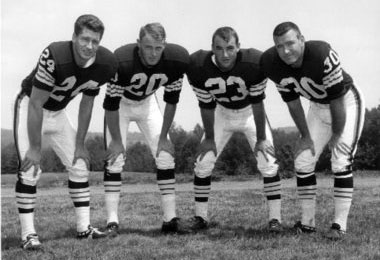
L-R:
Bobby Franklin, Ross Fichtner, Larry Benz, Bernie Parrish
The Browns were inundated by ticket requests.
The Colts entered the clash as seven-point favorites.
- The press almost universally predicted the Colts would win. Many even predicted a rout. Ed Shrake wrote in Sports Illustrated: It is yawningly conceded that the Eastern Conference champion Cleveland will be playing merely for the dubious pleasure of being thrashed by Baltimore on December 27. There are at least three teams in the West that are superior to any in the East. To be realistic about it, the championship game of 1964 has already been played. Baltimore won it in October by beating Green Bay for the second time.
Football historian Ernie Accorsi, who would later serve as general manager of both the Colts and Browns, recalled: No one, and I mean no one, outside of Cleveland gave the Browns a chance. The prevailing thought was that Unitas would score so many points that Cleveland would not be able to keep up. They would nullify Jim Brown.
- The Browns didn't even have support in their home area. Only one Cleveland writer, Chuck Heaton of the Plain Dealer, thought they'd win. Bob August wrote in the Press, I think I hear a ticking. I think it comes from the Colts and they will explode and win a title at the Stadium. A story in the Akron Beacon Journal on the game ran under the headline "Browns Fans Face Long, 'Colt" Afternoon."
Even the Browns owner had his doubts. The club vice-president recalled years later: Art told me that in his private moments, he worried the team might get beaten by 20 points. However, that pessimism was leavened by an even stronger desire to win after a chance encounter with Colts owner Carroll Rosenbloom a few days before the game.
I hope you don't embarrass us, Art said.
We'll try not to, replied Carroll.
Modell was angry. That wasn't the proper response. The guy looked at me as if there was no doubt his team would win. In fact, his attitude was that if they wanted to embarrass us, they could.
- However, Collier had the utmost confidence. Two days before the game, he told Cleveland writer Hal Lebovitz, Hal, we have covered everything. We are prepared. We are going to win. Knowing how unusual it was for a coach to express such optimism, Hal sensed that something special might happen on Sunday.
- Another factor in Blanton's optimism was that Jim Brown was in top physical condition after having been bothered by toe and hand ailments.
Both coaches hoped for a fast track and the weather forecast indicated they'd get their wish.
- The Colts arrived in Cleveland Christmas night (Friday) and staged a light workout Saturday.
- After going through a light, final drill at Western Reserve University Saturday morning, the Browns checked into a hotel for the evening. After the team went to a movie together, the offensive players held a meeting, led by Ryan, who asked what they thought would work.
The Browns were irritated to find that a contingent of Baltimore fans, including some members of the Colts Band, were staying in the same hotel. G John Wooten recalled what happened when he and his roomate, Jim Brown, went down to the snack bar. About fifteen of them (Colts fans) carried musical instruments. They saw us in the snack bar, and they came up to us and played taps right in front of our faces. Jim didn't say a word. He just got up and left, and I followed him. When we got away from those people, he turned to me and said, "We are going to kick the crap outta them."
- OT Dick Schafrath ran into Modell in the hotel lobby. Art, we're having a party after the game, Schafrath told his owner. Really? said Modell. We're winning the game, and you're paying for the party, Schafrath promised. Who told you that? asked Art. Gary Collins, came the reply. Okay, said Modell. You win, and you've got a deal.
|
1964 Baltimore Colts
| # |
Player |
Pos. |
Hgt. |
Wgt. |
College |
Exp. |
| 15 |
Gary Cuozzo |
QB |
6-0 |
195 |
Virginia |
2 |
| 19 |
Johnny Unitas |
QB |
6-1 |
195 |
Louisville |
9 |
| 20 |
Jerry Logan |
DB |
6-1 |
185 |
West Texas A&M |
2 |
| 24 |
Lenny Moore |
RB |
6-1 |
190 |
Penn State |
9 |
| 25 |
Alex Hawkins |
HB |
6-0 |
190 |
South Carolina |
6 |
| 26 |
Wendell Harris |
PR |
5-11 |
185 |
LSU |
3 |
| 28 |
Jimmy Orr |
FL |
5-11 |
185 |
Clemson, Georgia |
7 |
| 30 |
Alvin Haymond |
DB |
6-0 |
195 |
Southern |
1 |
| 31 |
Steve Stonebreaker |
LB |
6-3 |
225 |
Detroit |
3 |
| 32 |
Joe Don Looney |
FB-P |
6-1 |
230 |
TCU, Oklahoma |
1 |
| 33 |
Tony Lorick |
FB |
6-1 |
215 |
Arizona State |
1 |
| 35 |
Ted Davis |
LB |
6-1 |
230 |
Georgia Tech |
1 |
| 36 |
Bill Pellington |
LB |
6-2 |
235 |
Rutgers |
12 |
| 40 |
Bobby Boyd |
DB |
5-11 |
195 |
Oklahoma |
5 |
| 41 |
Tom Matte |
HB |
6-0 |
215 |
Ohio State |
4 |
| 43 |
Lenny Lyles |
DB |
6-2 |
200 |
Louisville |
7 |
| 45 |
Jerry Hill |
LB |
5-11 |
210 |
Wyoming |
4 |
| 46 |
Jim Welch |
DB |
6-0 |
195 |
SMU |
5 |
| 52 |
Dick Szymanski |
C |
6-3 |
235 |
Notre Dame |
10 |
| 55 |
Jackie Burkett |
LB |
6-4 |
240 |
Auburn |
4 |
| 60 |
George Preas |
T |
6-2 |
245 |
Virginia Tech |
10 |
| 61 |
Lou Kirouac |
LB-K |
6-3 |
250 |
Boston College |
2 |
| 66 |
Don Shinnick |
LB |
6-0 |
230 |
UCLA |
8 |
| 68 |
Alex Sandusky |
G |
6-1 |
235 |
Clarion |
11 |
| 71 |
Dan Sullivan |
G-T |
6-3 |
250 |
Boston College |
3 |
| 72 |
Bob Vogel |
T |
6-5 |
250 |
Ohio State |
2 |
| 73 |
Tom Gilburg |
T-K |
6-5 |
245 |
Syracuse |
4 |
| 74 |
Billy Ray Smith |
DT |
6-4 |
240 |
Auburn, Arkansas |
8 |
| 75 |
Guy Reese |
DL |
6-5 |
260 |
SMU |
3 |
| 76 |
Fred Miller |
DT |
6-3 |
250 |
LSU |
2 |
| 77 |
Jim Parker |
G |
6-3 |
275 |
Ohio State |
8 |
| 79 |
John Diehl |
DL |
6-7 |
265 |
Virginia |
4 |
| 79 |
Lou Michaels |
DE-K |
6-2 |
245 |
Kentucky |
7 |
| 81 |
Ordell Braase |
DE |
6-4 |
245 |
South Dakota |
8 |
| 82 |
Raymond Berry |
WR |
6-2 |
185 |
SMU |
10 |
| 84 |
Neal Petties |
E |
6-2 |
200 |
San Diego State |
1 |
| 86 |
Butch Wilson |
TE |
6-2 |
230 |
Alabama |
2 |
| 87 |
Willie Richardson |
WR |
6-1 |
200 |
Jackson State |
2 |
| 88 |
John Mackey |
TE |
6-2 |
225 |
Syracuse |
2 |
| 89 |
Gino Marchetti |
DE |
6-4 |
245 |
San Francisco |
13 |
|
1964 Cleveland Browns
| # |
Player |
Pos. |
Hgt. |
Wgt. |
College |
Exp. |
| 11 |
Jim Ninowski |
QB |
6-1 |
205 |
Michigan State |
7 |
| 13 |
Frank Ryan |
QB |
6-3 |
200 |
Rice |
7 |
| 20 |
Ross Fitchner |
DB |
6-0 |
185 |
Purdue |
5 |
| 22 |
Lowell Caylor |
DB |
6-3 |
205 |
Miami (OH) |
1 |
| 23 |
Larry Benz |
S |
5-11 |
185 |
Northwestern |
2 |
| 24 |
Bobby Franklin |
S |
5-11 |
180 |
Mississippi |
5 |
| 27 |
Walter Roberts |
FL |
5-9 |
165 |
San Jose State |
1 |
| 30 |
Bernie Parrish |
DB |
5-11 |
195 |
Florida |
6 |
| 32 |
Jim Brown |
FB |
6-2 |
230 |
Syracuse |
8 |
| 35 |
Galen Fiss |
LB |
6-0 |
225 |
Kansas |
9 |
| 36 |
Charlie Scales |
HB |
5-11 |
210 |
Indiana |
5 |
| 38 |
Stan Sczurek |
LB |
5-11 |
230 |
Purdue |
4 |
| 42 |
Paul Warwick |
FL |
6-0 |
190 |
Ohio State |
1 |
| 44 |
Leroy Kelly |
HB |
6-0 |
200 |
Morgan State |
1 |
| 48 |
Ernie Green |
HB |
6-2 |
205 |
Louisville |
3 |
| 49 |
Walter Beach |
CB |
6-0 |
190 |
Central Michigan |
5 |
| 50 |
Vince Costello |
LB |
6-0 |
230 |
Ohio |
8 |
| 52 |
Mike Lucci |
LB |
6-2 |
230 |
Pittsburgh, Tennessee |
3 |
| 56 |
John Morrow |
C |
6-3 |
245 |
Michigan |
9 |
| 60 |
John Wooten |
G |
6-2 |
235 |
Colorado |
6 |
| 62 |
Dave Memmelaar |
G-T |
6-2 |
245 |
Wyoming |
6 |
| 64 |
Ed Bettridge |
LB |
6-1 |
235 |
Bowling Green |
1 |
| 66 |
Gene Hickerson |
G |
6-3 |
250 |
Mississippi |
7 |
| 67 |
Sid Williams |
DE |
6-2 |
235 |
Southern |
1 |
| 69 |
Jim Kanicki |
DT |
6-4 |
270 |
Michigan State |
2 |
| 70 |
John Brown |
T |
6-2 |
250 |
Syracuse |
3 |
| 72 |
Mike Bundra |
DT |
6-3 |
255 |
USC |
3 |
| 73 |
Monte Clark |
T |
6-6 |
265 |
USC |
6 |
| 74 |
Dick Modzelewski |
DT |
6-0 |
250 |
Maryland |
12 |
| 75 |
Roger Shoals |
T |
6-4 |
260 |
Maryland |
2 |
| 76 |
Lou Groza |
K |
6-3 |
240 |
Ohio State |
19 |
| 77 |
Dick Schafrath |
T |
6-3 |
255 |
Ohio State |
6 |
| 78 |
Frank Parker |
DT |
6-5 |
270 |
Oklahoma State |
3 |
| 80 |
Bill Glass |
DE |
6-5 |
250 |
Baylor |
7 |
| 82 |
Jim Houston |
LB |
6-3 |
240 |
Ohio State |
5 |
| 83 |
Johnny Brewer |
TE |
6-4 |
230 |
Mississippi |
4 |
| 84 |
Paul Wiggin |
DE |
6-3 |
240 |
Stanford |
8 |
| 85 |
Clifton McNeil |
FL |
6-2 |
185 |
Grambling State |
1 |
| 86 |
Gary Collins |
FL |
6-5 |
215 |
Maryland |
3 |
| 87 |
Tom Hutchison |
TE |
6-1 |
190 |
Kentucky |
2 |
|
Light snow flurries fell the morning of Sunday, December 27 and off and on during the game.
- The great Red Smith described the conditions in the New York Times like this: The skies were a sullen gray, heavy with their freight of unspilled snow. The field was a spongy carpet of uprooted turf and the barren infield. The official game-time temperature was 32, but the wind of 20 mph kicked up white caps on Lake Erie and bit deep into the bones of the 79,554 customers.
- Don Robertson described the fans in the Plain Dealer. They brought blankets. They brought woolly hats. They brought face masks. And a great many of them brought anti-freeze, and after the game you could find many empty bottles of that anti-freeze.
- 8,000 Baltimore fans were swamped in massive Municipal Stadium.

Cleveland Municipal Stadium during the 1964 Championship Game
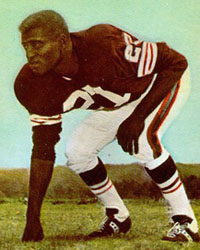
Walter "Flea" Roberts
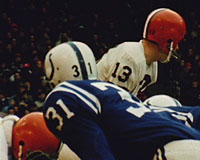
Frank Ryan barks out signals.
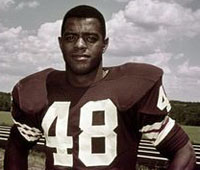
Ernie Green
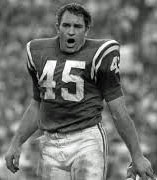
Jerry Hill
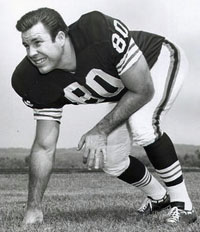
Bill Glass
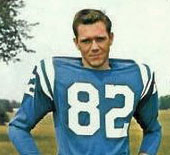
Raymond Berry

Larry Benz
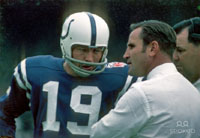
Unitas consults with Shula.
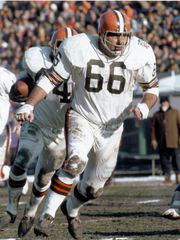
Gene Hickerson
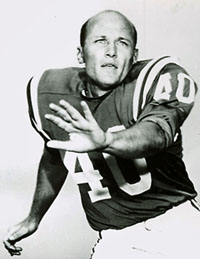
Bobby Boyd
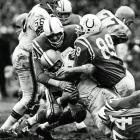
Colts led by Gino Marchetti (89) swarm Jim Brown.

Jimmy Orr
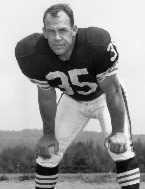
Galen Fiss

Bill Pellington (36) tries to cut off Brown.

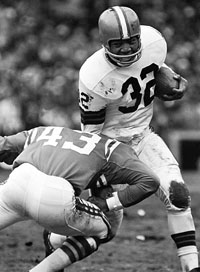
Lenny Lyles prepares to tackle Brown.
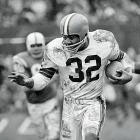
Brown on the loose.
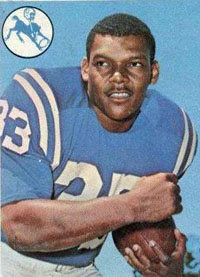
Tony Lorick
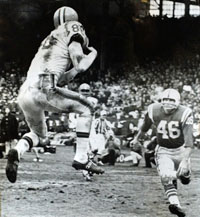
Gary Collins snags TD pass.

Brown tries unsuccessfully to go over the top.
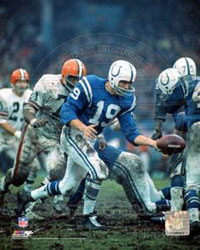
Unitas hands off.
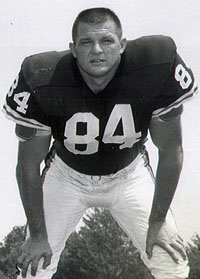
Paul Wiggin
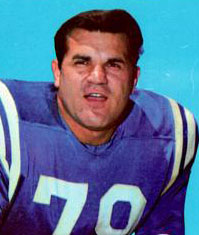
Lou Michaels
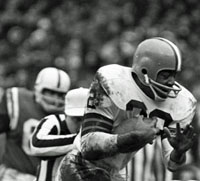
Even officials had to get out of Brown's way.

Unitas dejected.

Ryan carried off.
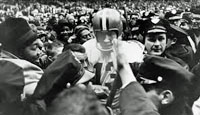
Police rescue Ryan.
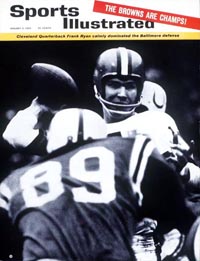
|
- Quarter 1
The Browns' opening possession started promisingly after Flea Roberts returned the kickoff to the 21. Runs by Ernie Green and Jim Brown totaled 10y and a first down. Soon, though, Cleveland faced third and 17 thanks to a 3y loss and a delay of game penalty. But Frank Ryan hit Brown circling over the middle. Jim snared the ball with one hand and rambled to the 46 for another first down. However, the next three plays gained only five more. So Gary Collins punted into the wind to Wendell Harris, who was downed on the 22.
Collins, the wide receiver who doubled as a punter, said cold weather never bothered him. It's because of my body temperature. My hands are never cold. My feet don't freeze. My temperature is usually between 96.8 and 97.2. Gary kept telling Ryan that, with the Colts double-teaming Warfield, he was open.
The Browns "clamping" coverage had an impact immediately. Johnny Unitas dropped to pass but could find no one open and ran for a yard. But the Browns were called for holding to make it first-and-10 at the 27. Lenny Moore found an opening and burst to the 43. Once again, Unitas couldn't find anyone open and had to run to midfield. But on the next play, Jerry Hill fumbled, and Dick Modzelewski recovered for Cleveland on their 49.
Baltimore, like most teams, was "right-handed." But early in the game, they lined up strong left more times than not. That meant they double-teamed Browns RE Bill Glass. Eventually, the Colts went back to their old ways.

Lenny Moore tries to find running room.
Brown recalled that the Colts took advantage of him when he was down. They kicked him in the ribs, tried to gouge his eyes. Someone stepped on his left hand, and Jim thought it was broken. It was numb for a while.
The Colts started to move. First, Unitas gave the ball right back to Hill, the fumbler, on a draw play for 2y. Then Johnny finally threw his first pass, connecting with Raymond Berry who got loose from S Ross Fichtner at the 43 and ran to the Cleveland 41. But on the next snap, Unitas couldn't find anyone open and ran again to the 25 where S Larry Benz banged him down. Colts radio announcer Frank Messer observed that Unitas was "running more today than he has all season." Hill gained three as the fast-moving period came to an end. END OF Q1: Browns 0 Colts 0
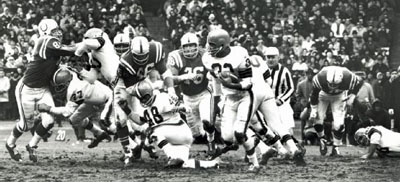
Brown skirts LE.
- Quarter 2
The visitors squandered an excellent opportunity to get on the scoreboard first. After Moore gained only a yard, Unitas threw a quick pass to TE John Mackey who has dropped immediately by Fichtner at the 19. So Lou Michaels lined up a 27y field goal. But Bobby Boyd fumbled the snap, picked it up, and tried to run but fell down at the 28 as the crowd roared.
The Browns continued to move the ball primarily on the ground. After Brown gained four, Ryan couldn't find a receiver and avoided the rush to the 35. He then pitched out to Jimmy who got the first down at the 39. Three straight runs by Green moved the chains again to the Baltimore 49. The relentless advance continued with Brown smashing to the 43. But then an illegal procedure penalty nullified a 10y scamper by Big Jim and made it second-and-10. Ryan tried to pass, but Ordell Braase sacked him with the help of Gino Marchetti back at the 49. A conservative draw play call on third-and-19 produced 3y. So Collins punted with the wind into the end zone with 6:46 showing. The high-scoring game many predicted was not transpiring.
Unitas flanked Moore in addition to Berry and Jimmy Orr to spread the defense. First, he gave the ball to Hill on a draw and Jerry pushed to the 26. Next a safety valve toss to Moore backfired when 33-year-old LB Galen Fiss, spying on Lenny, clipped Lenny's legs out from under him for a loss of five as the crowd went wild.
Fiss had broken his left thumb earlier in the season while making a clothesline tackle. Bernie Parrish recalled, They made one of those temporary casts and Galen used it to club people. I really think that Galen kept getting that hand taped long after the thumb healed. Fiss admitted, The cast did have its benefits. Slap people upside the head with that cast, you really get their attention. ... For games, we had to cover it with rubber and the officials inspected it, but it still was like a club. The cast went from my knuckles to about two thirds of the way to my elbow. The darn thing probably weighed two or three pounds, and by the time you swing your hand and land one, it's going to have an effect. Galen had also separated his left shoulder in college, and that injury never really healed.
Parrish also played through pain every game. I was playing with Morton's Neuroma on the ball of my foot. The doctors never quite figured it out. For four years, I took a novocaine shot in the ball of my foot on game day. If I didn't, I could barely walk, and the thing just hurt like hell.
Then Johnny found Berry for a first down at the 33. On third-and-five, Orr ran a slant-in from right end and made a leaping catch to the Cleveland 46 to continue the possession. Two plays later, though, Unitas threw to Mackey. Just as the big tight end got his hands on the ball, he was hit, causing the pigskin to pop into the air and come down in the hands of Vince Costello at the 29.
After the two-minute warning, Ryan found Collins to the 43 for a first down. But a holding penalty followed by offensive interference penalty derailed the march. Jerry Logan got a good return of Collins's punt from the 11 to the 29.
The Colts tried to move into field goal range but could get no further than their 36. They left the field stunned.
HALFTIME SCORE: Browns 0 Colts 0
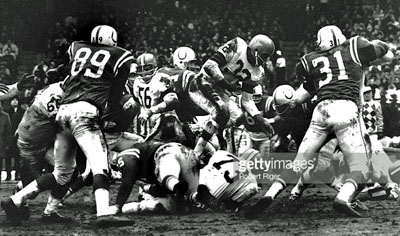
Brown gains hard yardage.
Art Modell's halftime show did not go as planned. He had paid $18,000 to fly in the Florida A&M band, which was known for its high stepping formations. Art promised Commissioner Rozelle that he would see a band that would put on a show unlike any he had ever seen before. Instead, the 180-piece band just walked on the field and played. Art, when will they do something? asked Pete. Soon, Modell said. But they never did. Afterward, the Browns owner confronted the band director. I saw you guys in the Orange Bowl, and you were all over the field. It was a great show. The band director said he wanted to showcase his school's excellent music department.
In the Cleveland locker room, Collier was surprised that he didn't have to make any defensive adjustments. So he asked for suggestions from his offense. They're stacking it up pretty well inside, said Brown. It might be time to throw the ball more. Collins said all there was between him and the goal line was little Bob Boyd, five inches shorter, and he could beat him any time he wanted.
The ever-nervous Parrish paced and paced. Finally, he couldn't take it any more. Hey, offense, are y'all ever gonna get into the game, or do we have to do all the work?
G John Wooten recalled, When the score was 0-0 at the half, I thought we had won the game. Everyone talked about our no-name defense and how they were overmatched, but Kanicki, Fiss, Beach, Parrish, Modzelewski–these guys were dominating the game. At halftime, we on offense promised them that we'd take care of business.
With the Colts receiving to start the second half, the Browns staff discussed whether they preferred the wind behind them in the third or the fourth quarter. Afterward Collier explained the decision. Most of the time you want the wind with you at the end of the game so you can rally if you have to. But I decided maybe we better take the wind while it was still blowing. If we gave it to the Colts and they got hot, we might be out of the game by the time we got it in the fourth. This proved to be a crucial decision that turned the game in Cleveland's favor.
- Quarter 3
Kicking with the wind, Lou Groza, a month away from his 41st birthday, boomed the ball beyond the end line. If the Colts made any offensive adjustments at halftime, they didn't work. An illegal procedure penalty mixed with two short runs and an incompletion forced T Tom Gilberg to punt into the wind. The ball went out of bounds on the Baltimore 48–a 25y punt.
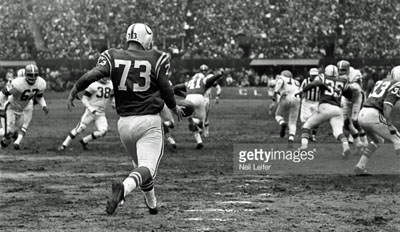
Tom Gilberg punts.
Following another touchback, Unitas tried to get something going. After an incompletion, he rolled out to his left to avoid the pressure only to be sacked at the 18 by Jim Kanicki, who was playing the game of his life.
The next Sports Illustrated reported that Kanicki looks very much like an enormous baby with soft, pink cheeks and what looks like baby fat still on his 270-pound body.
When a swing pass to Tony Lorick gained only five, Gilbert kicked into the gale again, but this time got off a good one that rolled all the way to the Cleveland 31.
Brown took a draw handoff for five. Then the Browns lined up in a double wing, with Green as a flanker to the left. The only man behind Ryan was Brown. RLB Shinnick cheated a little toward the middle. The defensive back opposite Green played 6-7y behind the line. Ryan tossed a quick pitchout to Jim swinging to his left. He swept around the pinched-in linebacker as Green knocked down Braase. Jimmy ran behind three blockers all the way to the Colt 18 where Logan made a touchdown-saving tackle from behind. Green got up from his first block and raced downfield where he took out MLB Bill Pellington to help the 46y gain.
Collier: We didn't use that sweep much in the first half. Maybe we were thinking too much. It had gained a lot of yards for us during the season, and we knew the Colts knew it. So we didn't go to it in the first half. It was very effective in the second half.
Green: That play really got us going. We finally broke Jim loose, and we knew we were going to be all right.
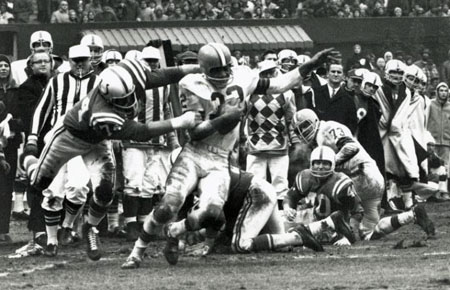

Brown breaks loose down the sideline.
Collins had noticed that Boyd was shading him toward the sidelines. So he broke the other way, heading for the goal post. Ryan had enough time to read the change and let fly. Five times that year he had hit a goal post. But this time, the ball went under the crossbar.
The Colts' woes continued when Lorick made a bad decision on the kickoff when he tried to run it out from 1y into the end zone. Not only was he taken down by a necktie tackle by rookie Leroy Kelly–destined to replace Brown someday–but a clipping penalty moved the ball half the distance to the six. After a 2y run, Unitas tried to pass but yet again ended up running for just a yard. He threw a short pass to Lorick who was felled at the 12. Gilberg wasn't so lucky on his punt this time, the ball going out 27y upfield to the Colt 39.
Smelling blood, Ryan called a reverse, but Braase hit Brown as he handed to Warfield who was downed for a loss of four. Undaunted, Ryan dropped back and lofted a high spiral with the wind toward Collins. Boyd slipped down on the dirt infield, and all Gary had to do was cradle the ball on the five and waltz into the end zone. Browns 17 Colts 0 (6:12)
That play was called Hook & Go. Collins faked the hook to freeze the defensive back, then ran straight for the end zone.
Ryan: This was probably the most important decision I had to make all afternoon. We had established tremendous momentum. The running was going; we had just gained 46y on a running play, and I was tempted to call another sweep. But maybe I would call a sweep into an outside blitz, and they would drop Jim for a long loss. Then I thought maybe we can go inside, but if they pinched in and cut off the inside we wouldn't gain, and the momentum could go from us to them. I knew they had been playing Gary Collins for a hook pass all afternoon. I decided to call a hook-and-go to Collins, and when he went he was open.
Gary was so wide open, I had buck fever, said Frank. There was no one within 20 yards of him. I had the wind at my back. It surprises you when a receiver is that wide open, but it happens occasionally. I just had to make sure I got him the ball, because Gary could have caught it and walked into the end zone.
Collins: When I faked, Bobby Boyd slipped and fell. When that ball was in the air, I kept thinking that if I dropped it, I had better catch a jet out of Cleveland right now.
Boyd: We couldn't hear our calls. We blew one on that play, and we blew another one later. The guy who was supposed to take the middle deep took the outside.
Unitas pulled out all the stops to produce some points. He started with his patented down-and-out to Berry, who got away from Walter Beach, but for only 4y. Then a pitchout to Moore got a first down at the 31. Three straight runs moved the chains again to the 42. Two plays later, Johnny threw in a quarterback draw to the 47. A third down pass to Moore was underthrown but defensive holding gave the Colts a first down at the Cleveland 48. And that's when disaster struck again. Moore never had control of the ball on the handoff from Unitas and fumbled, Paul Wiggin covering the ball at the Cleveland 47.
Browns defensive coach Nick Skorich explained his unit's success afterward: We crowded them. Especially when they were throwing into the wind and we knew that they could not throw long. We knew that the Colt pass patterns are built on precision and timing. We knew that if you take away the first receiver and force Johnny Unitas to go to a second or third you are forcing them out of a pattern, and, too, if you cover Jimmy Orr and Raymond Berry tight up close you force them to change their cuts and patterns and you take away the timing and the precision. ... And we got a strong rush inside, so he (Unitas) couldn't duck away from the rush from the ends and still find freedom to throw the ball.
On second-and-eight, Billy Ray Smith, newly inserted at defensive tackle, hit Ryan but a tad too late, the pass going to TE Johnny Brewer to the 37. Then the Browns ran a beautiful sweep around right end. Jimmy followed his interference all the way to the 14, where DT Fred Miller chased him down from behind.
END OF Q3: Browns 17 Colts 0

Ryan passes before Shinnick arrives.
- Quarter 4
When Warfield caught his first pass of the day to the one, it seemed a foregone conclusion that the Browns would go up 24-0. But the Colts stuffed two straight plunges by Brown. Then Lou Michaels hit Ryan before he could handoff, dropping him at the three. So Groza added the three-pointer. Browns 20 Colts 0
Would the goal-line stand light a fire under the Colts offense, which now had the advantage of the wind at their backs? Unfortunately for the visitors, the breeze had died down some.
Against the wind, Groza's kick came down at the 18. Tom Matte returned the ball to the 29. The possession started badly for Colts, Unitas being sacked for -4. But he came back with a completion to Orr to the 42. He then threw a long pass that Jimmy dived and caught at the 15. But the officials ruled he was out of bounds. Bill Glass spilled Unitas for a 4y loss. An overthrown aerial to Orr ended still another sterile possession for the Colts.
Starting from their 36 after Roberts's 14y punt return, the Browns could at least run some time off the clock. But they did much more than that. They moved smartly into Baltimore territory, thanks primarily to Ryan's 13y pass to Brewer and a pass interference penalty on Logan against Collins at the 35. A holding penalty back to the 49 threatened to take the starch out of the march. No problem, though. Ryan threw long again for Collins, the ball sailing just over the outstretched hand of Boyd who had Gary well covered at the 10. The 6'3" 210 lb WR escaped the grasp of the 5'10" 190 lb Boyd and ran through the end zone into a group of exuberant fans who engulfed him. A phalanx of policemen had to bail him out. Browns 27 Colts 0 (6:10)
Logan misread the Cleveland formation on the play. He thought it was a strong right–a formation in which his zone coverage was short and outside–when it was actually strong left. In a Cleveland strong-left formation, Logan's coverage was deep and in the middle. When he left that area, Collins broke into it.
The Colts never adjusted to help Boyd, who was an All-Pro defensive back. They held Warfield to one catch but paid the price on the other side. When a receiver and quarterback have a day like that, we call it Pitch & Catch, said Warfield. That was Frank Ryan to Gary Collins.
Even the Baltimore announcers agreed it would take more than one of Unitas's miracles to pull this one out.
The only question was whether Unitas & Company could avoid their first shutout in 31 games. But in another case of "just when you think everything that can go wrong has gone wrong ...," Modzelewski deflected Unitas's pass, sending it into the hands of Beach who returned it to the Colt 43 with 4:50 left.
The proud Blue and White defense finally forced a three-and-out, with Marchetti having the pleasure of dumping Brown for a 10y loss. But even that satisfaction was negated by a holding penalty on the punt that gave Cleveland an automatic first down at the Colt 46. That allowed the Browns to run out the clock. The Colts, led by Marchetti, managed to bury Ryan when he threw one last pass. Frank climbed wearily to his feet. He had welts on his nose and cheek. Collier took out Collins, then Warfield to allow the crowd to cheer for each. With less than a minute to play, fans started coming out of the stands, attacking both goal posts, invading the field, and finally forcing the officials to end the contest early. They surrounded Ryan and hoisted him on their shoulders.
FINAL: BROWNS 27 COLTS 0
The Browns' victory ended the seven-year reign of the Western Conference since the Giants beat the Bears in 1956.
Sports Illustrated's Tex Maule summarized the game like this: It was a bizarre game. Baltimore came to Cleveland as one of the finest offensive teams ever to win a divisional championship and left without having scored a point on the worst defense in the league.... But for this game, Cleveland became one of the great defensive teams of championship game history.
|
The Sport Magazine MVP award, a Corvette sports car, went to Gary Collins, who set a championship game record with three TD receptions.
Final statistics:
- First downs: Browns 20 Colts 11
- Rushing: Browns 41-142 Colts 25-92
- Passing: Browns 18-11-1/197 Colts 20-12-2/89
- Return yardage: Browns 4-44 Colts 6-61
- Fumbles-Lost: Browns 0-0 Colts 2-2
- Penalties: Browns 7-59 Colts 5-48
- Punting average: Browns 3-44.0 Colts 4-33.8
The individual statistics are enlightening
- Ryan completed 11 of 18 for 206y and 3 TDs. Unitas connected on 12 of 20 for just 95y.
- Did the Browns clamp down on the Colt receivers? Berry caught just 3 passes for 38y. Orr snagged only 2 for 31.
- Collins's 130y receiving was 35y more than the Colts' entire passing yards.
- The incomparable Brown (even to this day) carried 27 times for 114y against an outstanding defense that was hell bent on stopping him. The best Baltimore rusher was Moore with 40y. In fact, Brown outgained the Colts on the ground.
The Browns received $8,000 each. The losers' share was $5,000. Considering the average player's salary was $10,000-$15,000, that was quite a bonus.
Postgame
Cleveland Locker Room
Modell didn't order any champagne. He had wasted bottles for several weeks waiting for the Browns to clinch the East. And maybe he didn't want to jinx his underdog team. At any rate, his team didn't need alcohol to enjoy their championship.
After the game, the Cleveland owner embarrassed himself on national TV. He had imbibed too many cocktails during the game. I went on TV, and I was slurring my words. I've always regretted that.
- Collier: I know it's corny, but it really was a magnificent team effort. The defense was just great, and you've got to give them a lot of credit. ... The Colts have a good, fine football team. They had a few bad breaks, and we capitalized on them. Blanton said the Browns didn't make any major changes in the second half. We decided to stay with our running attack to try and loosen things up for our passing. We succeeded, and we also were able to take advantage when the Colts made a couple of mistakes. When asked how this club compared to the Otto Graham-led juggernauts for which he was an assistant coach, Blanton sidestepped the question. Let's just say it takes a pretty good club to win the title.
- Ryan gushed: I don't think any team can defense us. We have the personnel to do anything, and the only thing that beats us is when we don't execute. ... We wanted to control the ball, of course, and decided to throw the hook passes when they began defensing us outside. Then when they started to anticipate the hooks in the second half, we went deep. They were double-teaming Warfield and that left them weak on the other guys. That's how Gary was able to beat them so badly. ... They didn't hurt me much. They came after me, but during the game I didn't see them coming. I knew what I wanted to do, and I tried to do it. I think it worked pretty well. He said the cold didn't bother him but the wind did. I've never played a game in which it was so bad. When asked if it was his best game of the season, he said no. In fact, I don't think I played particularly well - only average. But I do think it was the best we've played as a team.
- Collier hugged Brown and thanked him for his leadership. Jim, who was uncharacteristically smiling and laughing, told reporters, It's the biggest thrill of my career. I have had better days as an individual, but this is the most satisfying of all. ... The field was pretty good for this time of the year. Sure it was rough out there. Those Colts hit hard. He responded to a question about Gino Marchetti, who played his last game for Baltimore. There is a fine football player and also a real gentleman. He hits hard and makes his tackles. And that's it. He doesn't have to resort to anything else. Gino is a class guy. Jim admitted he had been battling a cold for a few days.
- T Monte Clark on going against Marchetti: I knew I was playing one of the best. He's strong and tough, and I had to have some help occasionally, but I'm pleased with my contribution. This was a real team effort, offense and defense. ... The Lord certainly has been good to us.
- Collins had a simple explanation for his success. They were doubling on Paul Warfield so that had to leave somebody open. It just happened to be me. Gary praised his offensive line. We had real good pass protection so Frank had time to throw. Our line did a tremendous job against the Colts, who have the best defensive line in the league.
- Kanicki: I think that today I grew up. I found out how to play this game. He credited Modzelewski for helping him mature. He taught me an awful lot. I came into this league as green as you can get. I was too aggressive all the time, but too aggressive especially at the wrong time. ... But Mo and Blanton Collier worked with me and taught me to read blocks, and I finally learned not to be suckered. All the time out there today, Mo talked to me, like he has all season. He'd say, this time put on the big rush. Or look for the run. Little things. I was scared to death before the game, me playing head on Jim Parker, maybe the best blocking lineman in the league. But we crowded him and pushed him, and we figured that if I would hand fight instead of firing out I could do better. It worked pretty well.
- When Modzelewski came out of the shower, he told the reporters who were questioning Collier, Let me by. I'm wet, and I'll get you wet. They parted and let him through. But he did not get by his coach, who embraced him. Thanks, Blanton said. Thanks. Mo said, It was a good trade. I never had a better season. Collier told the reporters, I don't know how we got Modzelewski. I don't know how they (the Giants) could give him up. But we were lucky we got him.
- Parrish: Were we tall enough out there today? We won five in a row early in the season, and no one thought we were short. Then we lost some games, and I began to feel like a midget because people started to write that the Brown secondary was too short. We grew a few inches this afternoon.
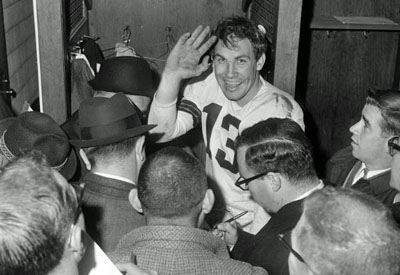
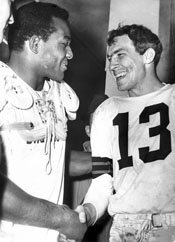
L: Ryan the center of attention. R: Brown and Ryan enjoy victory. Baltimore Locker Room
In contrast to the pandemonium next door, the Colts quarters was silent.
- Shula was disgusted with his offense. Their defense did a heck of a job, but when you say that, you also have to mention our complete lack of offense. We couldn't get anything done. Was it Unitas's fault? he was asked. We had zero points on the scoreboard. I wasn't satisfied with anyone. They used a lot of man-to-man coverage and mixed it up pretty well. And they used a somewhat unusual spacing in the line, but they had shown it before. We just killed our own drives by giving up the ball twice on fumbles and twice on pass interceptions. We never gave our defense a break. Heck, when you can't move it and keep putting constant pressure on the defense, you can't expect to win. Then they threw three bombs on us. Don thought the wind played a role in "breaking up the game" in Q3. They got us backed into the corner, and we couldn't get out. Asked if he thought the Colts lost their edge when they clinched the Western Conference pennant with four games to play, he said he wasn't sure. We got going in the second half of the last game when we beat Washington 45-27. But when we got beat like we did today, I just don't know. And we got beat in every phase of the game. Maybe it was just a day we didn't do anything right. They beat us in every conceivable way.
- Unitas didn't have much to offer. It just wasn't our afternoon. They just beat us is about all you can say. ... That was not the way I wanted it to go. I wanted to go out and gun them down, but their defense didn't allow that. So I had to play it conservative. They shut off the bombs.
- Defensive captain Pellington: We were just flat on our backs all day. When you can't control the ball, it's bound to happen.
- Alex Hawkins, captain of the Colts special teams: The worst came out in us and none of the best. It makes you sick to your stomach so that you want to get out and play 'em again for nothing.
1964 NFL Championship Game participants in the Pro Football Hall of Fame.
Browns: Jim Brown, Lou Groza, Leroy Kelly, Paul Warfield
Colts: Raymond Berry, John Mackey, Gino Marchetti, Lenny Moore, Jim Parker, Johnny Unitas
Aftermath
Thirty years later, Browns DE Paul Wiggin expressed feelings that many of his '64 teammates could understand. If you were to ask me what was the greatest feeling in my life, it was winning that championship. I don't wear jewelry. I don't wear my wedding ring. But for years, I wore that championship ring. My wife asked me why, and I tried to tell her that for one moment in my life, nothing has ever meant as much to me as that championship. It only lasted a short time, but to have that feeling about being the best in the world ... As I walked out of the Stadium that day, there was a telephone pole. I wanted to climb up that pole and just yell to the whole city of Cleveland that I was a part of the best football team in the world ... We had a group of guys from Georgia, California - you name it. White guys, black guys, it didn't matter. Nothing mattered except on that one day, we came together and did something very special. I have spent a lot of years in pro football trying to duplicate that feeling, and I never have.
1964 NFL Champion Cleveland Browns
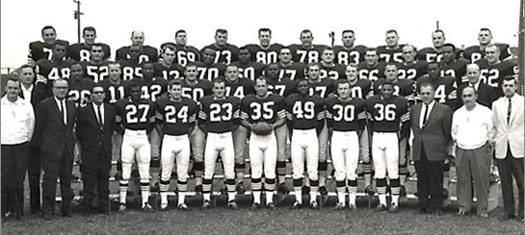
References: "Upset of the Mighty," Tex Maule, Sports Illustrated 1/4/1965
When All the World Was Browns Town: Cleveland's Browns and the Championship Season of '64, Terry Pluto (1997)
Jim Brown: The Fierce Life of an American Hero, Mike Freeman (2006)
Top of Page |
|























































